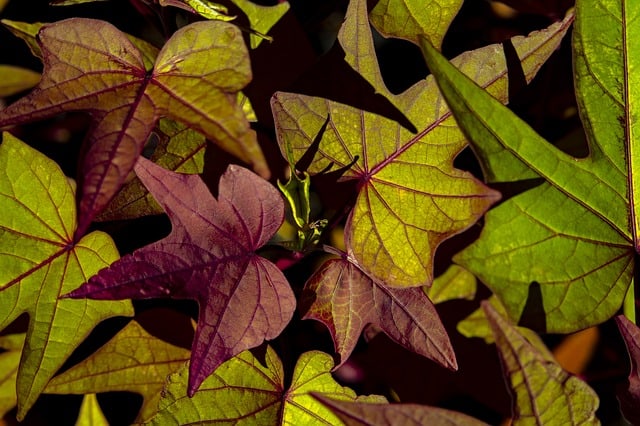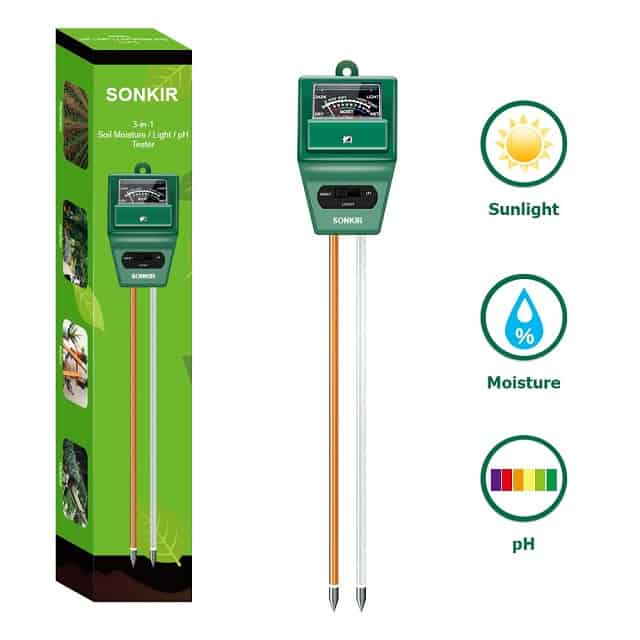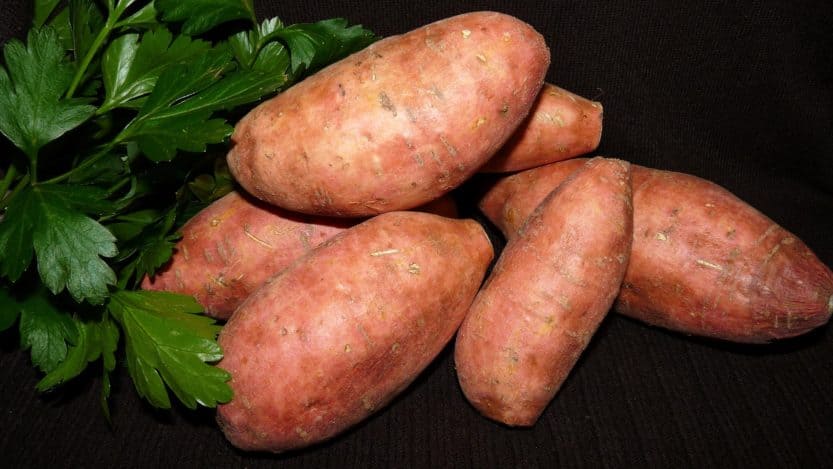Sweet potatoes are a low-maintenance plant, well suited to both the garden and decorative plantings. Sweet potatoes are an excellent source of vitamin A; and a very good source of vitamin C, manganese, copper and vitamin B6.
Buy Sweet Potato Slips Online
| Image | Name | Rating | Shop |
|---|---|---|---|
 | Burpee Sweet Potato Slips | ||
 | 5 White Yam Sweet Potato (Plants/Slips) | ||
 | Purple Sweet Potato,Okinawa |
Types of Sweet Potatoes to Grow
Sweet potatoes have two main growth habits, which are vine and bunching. The vine types tend to sprawl, which means they need a lot of horizontal space; while the bunching types will generally maintain a tighter form, making them ideal for small gardens.
White and Purple Sweet Potato
Most people are familiar with the orange-fleshed sweet potatoes found in grocery stores, but sweet potatoes come in many colors, ranging from white to purple. White sweet potatoes tend to be sweeter, with a mild flavor and a starchy flesh.
Purple sweet potatoes (Buy Online) are not as common and are usually found in specialty markets They have a rich, deep-purple flesh that is very high in antioxidants, rivaling berries in some cases.
Orange Sweet Potatoes
Orange sweet potatoes are the most common, having a soft flesh and a rich flavor, with a large amount of beta-carotene, which accounts for their color.
Starting Sweet Potato Slips
Sweet potatoes are usually started from sprout “slips” that are removed from a mature sweet potato. While it is possible to start a sweet potato plant from seed, it’s generally not a common practice, as the seeds do not breed true to their parents.
Starting a sweet potato plant from “slips” is quite easy, and you can sprout a sweet potato purchased from the store, or you can buy slips from a nursery or catalog. Once you get your slips, place them in a glass of water in a sunny spot in the house.
Starting Sweet Potatoes Indoors
Sweet potato slips can be kept indoors until the weather warms up. Since sweet potato plants are a tropical vine, they should be planted no sooner than one month after the last frost in your area. In warmer areas, that do not experience hard frosts, you can plant sweet potatoes at any time; and in these conditions, they will perennial.
Planting Sweet Potatoes

Do Sweet Potatoes Need a lot of Sun?
Find a location in your garden that gets full sun all day, especially in the early spring. The sun will help your plants establish themselves faster, by heating the soil; and the heat will also enhance the plants’ growth rate early in their life.
Sweet Potato Soil Requirements
Sweet potatoes actually prefer poor soils, in order to produce a bumper crop. If your soil is too rich, you will get very lush vine growth; but the roots will be small and spindly. Try to find a spot in the garden that has very loose, sandy soil, where other crops might have had a hard time growing.
Sweet Potato Soil pH

The soil should have a pH of 6.0 to 6.8 (Buy pH Tester Online), as sweet potatoes prefer a soil that is neutral to slightly acidic. Try and till the soil to a depth of at least 12 inches (30.5 cm) and remove any obstructions, such as rocks or roots, so that the sweet potatoes do not become misshapen.
Sweet Potato Growing Temperature
Once your soil is ready and the soil temperature is above 60 degrees Fahrenheit (15.5 C), then sweet potato slips should be planted 3 inches (7.5 cm) deep and have a final spacing of 10.5 inches (26.7 cm).
After you plant your slips, gently water the plants every day for about a week, until you see the plants perk up. Be sure to keep any weeds under control, while the slips are getting established. You can carefully pull the weeds that are growing close to the plants, while only using a hoe to cultivate the soil further away from the plants.
Sweet Potato Weed Control
Another good weed control method that works well with sweet potatoes is to use a black plastic mulch, as this will inhibit weeds and heat the soil. While a mulch might be needed early on in the season, sweet potato vines will eventually create a nice thick ground cover that will act as a living mulch.
Sweet Potato Care & Harvest

Sweet Potato Water Requirements
Sweet potato plants will require 1 inch (2.5 cm) of water every week, once they are fully established. If at any time you see yellowing of leaves or any other signs of nutrient deficiency, then immediately fertilize the affected plants. Be careful not to over-fertilize the plants; because this can lead to lush vine growth, but reduced root size.
Sweet Potato Pests and Diseases
While the sweet potato plants are growing, be sure to keep an eye out for any insect infestations, such as wireworms, nematodes or Japanese beetles. Damage to the leaves by insects, like Japanese beetles, is usually cosmetic since the new growth will make up for the parts that were eaten.
Sweet Potato Wireworm Control
Wireworms and nematodes are a harder problem to detect; and the problem is usually only noticed until after the harvest when it is too late to do much about it. If you know your area is prone to wireworm or nematode problems, then you can apply soil treatments before you plant your crop to try and limit any damage.
When are Sweet potatoes Ready to Harvest
Sweet potatoes require a long growing season, which is anywhere from 100 to 120 days. The vines should start to look a little worse for wear once the weather starts to cool down. While it may be tempting to let the vines die back after your first frost, you should never let that happen.
If the vines experience a frost, it could damage the roots, making them prone to prematurely rotting. To be safe, try to harvest all the sweet potatoes 2 to 4 weeks before the first frost in your area.
How Do You Harvest Sweet Potatoes?
When harvesting sweet potatoes, you should use a garden fork to loosen the soil around the roots, being careful not to damage any sweet potatoes in the process. Then carefully dig the sweet potatoes out by hand, making sure not to snap any of the long, delicate roots.
How Do You Cure Sweet Potatoes?
Sweet potatoes will keep longer if they are “cured”, which entails keeping them at 85 to 90 degrees Fahrenheit (29 to 35 C) and at 80 to 90 percent humidity for 5 to 10 days.
Storing Sweet Potatoes for the Winter
After they have been cured, they should be stored at a temperature of 70 degrees Fahrenheit (21 C). Sweet potatoes will keep in storage for about 6 to 12 months.





